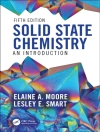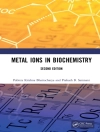This two-volume book provides an overview of physical techniques used to characterize the structure of solid materials, on the one hand,
and to investigate the reactivity of their surface, on the other. Therefore this book is a must-have for anyone working in fields related to surface
reactivity. Among the latter, and because of its most important industrial impact, catalysis has been used as the directing thread of the book.
After the preface and a general introduction to physical techniques by M. Che and J.C. Vedrine, two overviews on physical techniques are
presented by G. Ertl and Sir J.M. Thomas for investigating model catalysts and porous catalysts, respectively.
The book is organized into four parts: Molecular/Local Spectroscopies, Macroscopic Techniques, Characterization of the Fluid Phase (Gas and/
or Liquid), and Advanced Characterization. Each chapter focuses upon the following important themes: overview of the technique, most important parameters to interpret the experimental data, practical details, applications of the technique, particularly during chemical processes,
with its advantages and disadvantages, conclusions.
Table des matières
PREFACE
GENERAL INTRODUCTION
OVERVIEW ON PHYSICAL TECHNIQUES FOR INVESTIGATING MODEL SOLID CATALYSTS
OVERVIEW ON PHYSICAL TECHNIQUES FOR INVESTIGATING POROUS CATALYSTS LV
VOLUME 1
PART ONE MOLECULAR/LOCAL SPECTROSCOPIES
INFRARED SPECTROSCOPY
Introduction
Principles of IR Spectroscopy and Basic Knowledge for Its Use
Experimental Considerations
Use of IR Spectroscopy to Characterize Solids
Application to Surface Reactivity: Operando Spectroscopy
Conclusion
RAMAN AND UV-RAMAN SPECTROSCOPIES
Introduction
Characterization of Active Sites and Phase Structure of Metal Oxides
Characterization of Surface Metal Oxide Species on Supported Metal Oxides
Electron-Phonon Coupling in Nanostructured Materials
Characterization of sp2 Carbon Materials
Characterization of Transition Metal-Containing Microporous and Mesoporous Materials
Synthesis Mechanisms of Molecular Sieves
Conclusions
ELECTRONIC SPECTROSCOPY: ULTRA VIOLET-VISIBLE AND NEAR IR SPECTROSCOPIES
Introduction and Overview
UV-vis-NIR Spectra
Experimental Considerations
Formation and Alteration of Solids
Surface Reactivity and Catalysis
Conclusions
PHOTOLUMINESCENCE SPECTROSCOPY
Introduction
Basic Principles of Photoluminescence
General Aspects of Photoluminescence Measurements Characterization of Catalysts by Photoluminescence and Time-Resolved Photoluminescence Spectroscopy
Investigations of the Dynamics of Photocatalysis by Time-Resolved Photoluminescence Spectroscopy
Conclusion
NEUTRON SCATTERING
Introduction
Introduction to the Theory
Experimental
Structure
Dynamics
Conclusion
SUM FREQUENCY GENERATION AND INFRARED REFLECTION ABSORPTION SPECTROSCOPY
Introduction
Theoretical Background of SFG
Spectrometer Setup
Case Studies
Conclusion
INFRA RED REFLECTION ABSORPTION SPECTROSCOPY AND POLARISATION MODULATION-IRRAS
Introduction
Principle of IRAS
Principle of PM-IRAS
Applications of IRAS and PM-IRAS
Conclusion
NUCLEAR MAGNETIC RESONANCE SPECTROSCOPY
Introduction and Historical Perspective
Theory
Popular NMR Techniques for Studying Solids
Characterization of Heterogeneous Catalysts
Porosity, Adsorption, and Transport Processes
‘In Situ’ NMR
Towards ‘Operando’ Studies
Conclusion and Outlook
ELECTRON PARAMAGNETIC RESONANCE SPECTROSCOPY
Introduction
Principles of EPR
Electron-Nucleus Hyperfine Interaction
Experimental Background
Anisotropy of Magnetic Interactions in EPR: the g, A, and D Tensors
EPR Spectra and the Solid State: Single Crystal Versus Powders
Guidelines to Interpretation of EPR Spectra
Computer Simulation of Powder Spectra
Molecular Interpretation of Parameters
Quantum Chemical Calculations of Magnetic Parameters
Advanced EPR Techniques
Characteristics of EPR Techniques in Application to Catalysis and Surfaces
Interfacial and Surface Charge-Transfer Processes
In Situ and Operando EPR Techniques
Conclusions and Prospects
MOSSBAUER SPECTROSCOPY
Introduction
The Mossbauer Effect
Radiation Source
Mossbauer Absorbers
Hyperfine Interactions
Experimental Setups
Evaluation of Experimental Data
Theoretical Calculation of Mossbauer Parameters
Common Mossbauer-Active Transitions
Survey of Applications of the Mossbauer Effect in the Study of Catalytic Materials
Conclusion
LOW ENERGY ION SCATTERING AND SECONDARY ION MASS SPECTROMETRY
Introduction
Secondary Ion Mass Spectrometry
Low-Energy Ion Scattering (Ion Scattering Spectroscopy)
Single-Crystal and Polycrystalline Metal Surfaces
Amorphous Metallic Alloys
From Model to Real Catalysts
Conclusion
X-RAY ABSORPTION SPECTROSCOPY
Introduction
History of X-Ray Absorption Spectroscopy
Principle of X-Ray Absorption Spectroscopy: XANES, EXAFS
Experimentation and Data Processing
Application to Oxide Materials
Applications to the Study of Sulfide Catalysts
Application to Metal Catalysts
Conclusion and Perspectives
AUGER ELECTRON, X RAY AND UV PHOTOELECTRON SPECTROSCOPIES
Introduction
Sources of Analytical Information
Instrumentation
Case Studies
Outlook
SINGLE MOLECULE SPECTROSCOPY
Introduction
Description of the Method
Experimental Considerations and Constraints
Mesoporous Silica Materials
Selected Studies
Conclusion
VOLUME 2
PART TWO MACROSCOPIC TECHNIQUES
X-RAY DIFFRACTION AND SMALL ANGLE X-RAY SCATTERING
Introduction
Theoretical Background of X-Ray Diffraction
Experimental Aspects
Application to Phase Identification
Application to Phase Characterization: Ideal Structure
Application for Phase Characterization: Real Structure
X-Ray Diffraction of Catalysts in a Reactive Atmosphere
Small-Angle X-Ray Scattering (SAXS)
Conclusion
TRANSMISSION ELECTRON MICROSCOPY
History and Overview
Introduction
Specimen Preparation and Experimental Considerations
Examples of General Characterization Studies
Examples of Reactivity and Catalysis Studies
Recent Developments and Future Prospects
SCANNING PROBE MICROSCOPY AND SPECTROSCOPY
Introduction
Scanning Tunneling Microscopy
Atomic Force Microscopy
Conclusion
THERMAL METHODS
Main Thermal Methods
Acidity/Basicity
Redox Properties of Solids
Conclusion
SURFACE AREA/POROSITY, ADSORPTION, DIFFUSION
Introduction
Gas Adsorption for the Characterization of Surface Area and Porosity
Diffusion in Porous Solids
Conclusion
PART THREE CHARACTERIZATION OF THE FLUID PHASE (GAS AND/OR LIQUID)
MASS SPECTROMETRY
Linked Atom Theory and the Mass Spectrometry Stories: the Premises of Modern Mass Spectrometry Technology Basics of Mass Spectrometry
Direct Surface Analysis: Imaging Mass Spectrometry for Biologists
From Collision Activation to Ion?Surface Chemical Reactions for New Preparative Mass Spectrometry
Petroleomics: Role of Ultra-High Resolution and Data Treatment
Conclusion
CHROMATOGRAPHIC METHODS
Introduction
Analysis at Different Scales
GC _ GC: a Revolutionary Analytical Technique for Detailed Molecular Analysis
Towards Molecular Analysis Systems Highly Coupled Around GC _ GC
Conclusion
TRANSIENT TECHNIQUES: TEMPORAL ANALYSIS OF PRODUCTS AND STEADY STATE ISOTOPIC TRANSIENT KINETIC ANALYSIS
Scope
Temporal Analysis of Products (TAP)
Steady-State Isotopic Transient Kinetic Analysis (SSITKA)
Conclusion
PART FOUR ADVANCED CHARACTERIZATION
TECHNIQUES COUPLING FOR CATALYST CHARACTERISATION
Introduction
Basic Tenets Behind Technique Combining
Illustrations of Setups Combining Multiple In Situ Techniques
Conclusion
QUANTUM CHEMISTRY METHODS
Introduction and Historical Perspective
Building Models of Heterogeneous Catalysts
Electronic Structure Calculations
Application of Total Energy Calculations to the Structure of Catalytic Surfaces Under the Conditions of Catalysis
Conclusions and Outlook
A propos de l’auteur
Michel Che studied chemistry and, after recruitment by CNRS, obtained his Doctorat es Sciences (University of Lyon, F) in 1968. He worked as post-doc at Princeton University (USA) (1969-1971) and then as frequent visiting scientist at the Atomic Energy Research Establishment,
Harwell (UK) (1972-1982). He became Professor at the University Pierre & Marie Curie, Paris in 1975 and Boris Imelik Chair Professor of Institut Universitaire de France in 1995. His research concerns spectroscopy, surface reactivity and heterogeneous catalysis. He was President-Founder of the European Federation of Catalysis Societies (starting the biennial Europacat congresses) and later of the International Association of Catalysis Societies. His scientific and educational work earned him several international awards, lectureships and honorary doctorates.
Jacques C. Vedrine studied chemistry and, after recruitment by CNRS, obtained his Doctorat es Sciences (University of Lyon, F) in 1968. He worked as post-doc in USA at Varian Associates, Palo-Alto (1969-70) and at Princeton University (1970-71). He was deputy director of
the Institut de Recherches sur la Catalyse, CNRS in Lyon (1988-1998) and Chair Professor at Liverpool University, UK (1998-2003). He is one of the Editors of Appl. Catal. A: General. His research field covers physical techniques of catalyst characterization and heterogeneous catalysis for acid- and selective oxidation-type reactions on zeolites and mixed metal oxides. He was President of the European Federation of Catalysis Societies and of the Acid-Base World Organization. His scientific and educational work earned him several awards, and an honorary doctorate.












